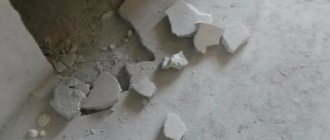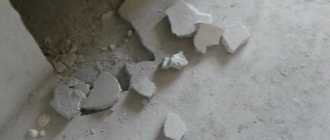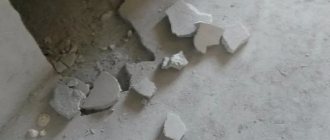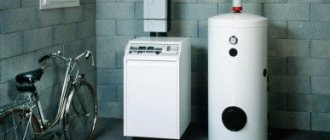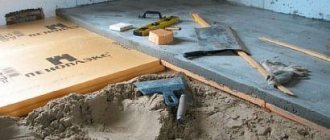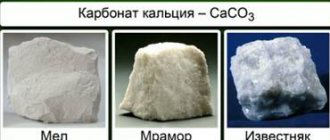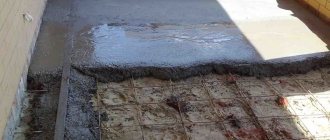Rough finishing is an invisible but very important part of the renovation. The quality of its implementation determines how the final coating will look and how long it will last in its original form. Therefore, before starting finishing work, you need to make sure that the base is strong and reliable, and, if necessary, eliminate defects. If, after leveling, cracks appear in the floor screed, what to do with such a base must be decided on the spot, depending on the scale of the damage, the area of the object, and the type of finished floor covering.
Sometimes it is easier to redo a screed than to repair it Source homemasters.ru
Looking for the cause of the problem
To solve the problem once and for all, you need to find and eliminate the cause of its occurrence, otherwise it will recur. This also applies to situations where the floor screed is cracked - what to do with the cracks can only be decided after you understand why they appeared.
In general, on a surface finished with cement mortar, cracks often form due to the low plasticity of the material and its ability to expand and contract with temperature changes. Their occurrence can be avoided only by strictly following the technology of mixing the solution, preparing the base, installing the screed and fulfilling the conditions necessary for its uniform drying.
The slightest deviation in any of the above points is likely to cause cracking of the cement coating. Most often this happens in the following cases:
- errors when mixing the solution - excess water or uneven distribution of components in the mixture;
Liquid solution has less strength Source strojlyuks.ru
- insufficient screed thickness;
- weak, sagging or vibrating foundation under the screed;
- absence of damper joints or technological gaps between the screed and the walls;
- uneven drying of the solution due to drafts, temperature changes or as a result of forced drying.
The listed factors refer to gross violations of the manufacturing technology of concrete floor screed, which may lead to the impossibility of restoring the coating using spot repairs. If it is covered with deep cracks over the entire area, crumbles underfoot or “breathes,” the screed must be dismantled and remade.
Dismantling a screed is a dirty, time-consuming and expensive job, so it’s better to do everything right right away Source amazonaws.com
If concrete was poured on an unstable sandy base, on a wooden floor or thermal insulation slabs, and the floor screed cracked, what to do: pour another layer on top with mandatory reinforcement with steel mesh.
Defects in a fresh cement coating may not appear immediately, so after finishing the work you need to wait at least 3-4 weeks and then carry out an inspection. To do this, tap the screed with a rubber mallet, revealing local delaminations of the concrete, and strips of thin paper are glued onto the cracks and left for 10-14 days. If after this time it remains intact, it means that the cracks are stable and will not deepen or expand. If the paper is torn, this indicates that the concrete layer is unreliable - it will continue to deteriorate.
Why does a concrete floor collapse?
In practice, the destruction of concrete screeds occurs for several reasons. Most often, the negative effects of soils and the aggressive effects of external and internal factors are observed. The soil base begins to move in case of poor preparation (insufficient compaction); swelling may occur in unheated rooms . Without taking into account the groundwater level, the foundation is eroded. All this inevitably leads to damage.
Internal factors include shrinkage phenomena and incomplete surface care after pouring the solution.
External reasons - wear of concrete during operation, accompanied by dust, the appearance of chips and potholes due to loads.
Making expansion joints
One of the main reasons for cracking of a concrete slab is the lack of compensation gaps around the perimeter of its abutment to vertical barriers - walls, columns, thresholds, etc. And in rooms with a large area, the screed can crack and swell during shrinkage and during linear expansion, if expansion joints are not installed in it, dividing the solid slab into several sections independent from each other.
The expansion joint allows the screed to expand freely Source tb.ru
See also: Catalog of companies that specialize in home insulation
Before repairing cracks in the floor screed, it is necessary to arrange all the necessary technological joints in it, otherwise they will appear again and again. And the sooner you do this, the better.
It will no longer be possible to create gaps between the floor and the wall using a finished screed. But you can cut the grooves as close to the wall as possible using a grinder with a large diameter disk or a wall chaser. If there are columns, a shrinkage seam is made around them, but not parallel to the edges, but in the form of a diamond, so that the corner of the column looks at the straight section of the groove.
If the dimensions of the room on one or both sides exceed 3-4 meters, the seams must be cut across it.
Note! The depth of the groove must be at least a third of the thickness of the screed, and the width must be at least 10 mm.
The finished cracks in the floor are cleaned of debris and primed. After the primer has dried, they are filled with polyurethane sealant or special mastic. After drying, these compositions retain elasticity, which will allow the cut cards to move independently of each other without transferring deforming loads.
Filling the seam with sealant Source stiagka-pola.ru
Mixer and rule
All repair compounds for concrete must be mixed: ready-made with water; homemade - with PVA suspension. It is impossible to knead manually: the finished solution must be as “dry” as possible, i.e. water or suspension is added in a minimal amount. A very viscous mixture will have to be “pounded” for too long to achieve the desired homogeneity, and irreversible changes will begin in it, deteriorating the quality of work.
To mix small volumes of repair building compounds, I use an electric drill or hammer drill at low speeds with a special attachment - a mixer. The principle of its operation is no different from a cocktail mixer.
In tool stores you can find a wide selection of different mixers, sometimes in completely bizarre configurations. But a mixer, in no way inferior to them, is made from an even rod 8-10 mm in diameter and half a meter long, the end of which is bent into a ring or simply folded in half.
The kneading lasts 3-5 minutes. When kneading in a bucket, move the tool in a circular motion; in the trough - transverse zigzag. You should have a bucket of water at hand - after kneading, the mixer should be rinsed immediately by immersing it in water and turning it up to high speed. When mixing with a hammer drill, you should never turn on the impact mechanism: the entire room and you will immediately find yourself covered in a thin layer of concrete.
In addition to a mixer, to repair a concrete floor you will need a rule - a wide, one meter, spatula. A plaster float will not work: it will not smooth out the concrete properly, and will wear off on it itself. The rule, on the contrary, is to purchase a factory one, and you should not skimp on it, especially since it is inexpensive. Concrete is a good abrasive, and if the middle of the rule turns out to be “eaten away,” then the floor will turn out humpbacked.
We repair the screed
How to repair cracks in a floor screed depends on the degree of deformation of the subfloor.
Sealing microcracks
Shallow, small cracks usually do not cause problems. They arise due to improper concrete drying conditions. If they begin to appear soon after pouring, the floors should be wetted and covered with film.
Very thin microcracks can be left untouched or covered with liquid cement mortar or tile adhesive. If the width reaches several millimeters, it is better to play it safe and seal such cracks to the full depth.
- The crack is opened by cutting off the concrete on both sides of it with a grinder with a diamond blade, which is set at an angle to the crack.
If the amount of work is small, you can get by with a chisel and a hammer Source wp.com
- Pieces of concrete and cement dust are removed from the resulting triangular furrow.
- Its walls are well impregnated with a deep penetration primer.
- After the primer has dried, fill the recesses with the solution, applying it with a small slide.
- As soon as the solution sets, but does not completely harden, the excess is removed from the surface with a spatula.
If you immediately level the repair mixture over the surface, then during the drying process it will shrink and a depression will form.
Preparatory stage
The basic preparatory process for all methods is as follows. The first step is to dismantle the floor covering. It is advisable to dry the floor for a day or several days before carrying out repair work, and then carefully remove all debris.
Rust, mold and old primer are removed with a wire brush. Grease stains and paint are removed with chemicals. The better the surface is prepared, the better the repair will be done. If the reinforcement is “exposed,” it is cleaned and anti-corrosion treatment is carried out. The further repair process depends on the damage.
Video description
How to strengthen concrete that is peeling off from the base is described in the video:
Having found out why the floor screed cracked and what to do, you can begin repairs.
- First, by tapping, areas of delamination and voids are identified and marked with chalk.
- In the marked places, holes are drilled in the screed at a distance of 15-20 cm from each other.
- After cleaning and priming, an epoxy mixture is poured into the holes.
- It also seals cracks.
- After the mixture hardens, the holes are filled with liquid cement mortar.
It is important! This method cannot be used if a water or electric heated floor system is installed in the screed, or other communications without an accurate wiring diagram.
When drilling repair holes, there is a high risk of damaging the cable Source sense-life.com
Preparing the premises
Preparing to repair a concrete floor comes down to emptying the room and thoroughly cleaning it. Large debris is raked with a shovel, then the floor is thoroughly swept two or three times with a wet broom and spraying. After each sweep, potholes and cracks are blown out with a household vacuum cleaner after the floor has dried.
If you have the opportunity to use an industrial vacuum cleaner, preparing the floor can be done in an hour: suck the floor, blow out potholes with cracks, suck again - and that’s it, the preparation is complete.
Is crack repair always necessary?
Even experienced craftsmen cannot always guarantee that the cement screed will retain its solidity and integrity, since, despite its hardness and strength, it is a fragile material that is completely unable to adapt to environmental changes and withstand excessive loads.
In addition, having an impressive weight, the poured concrete slab under the final coating will not go anywhere, even if it cracks. It is not necessary to repair it if:
- the cracks are small and rare, not prone to expansion;
- when tapping with a mallet or walking along the edges of cracks, dust does not rise from them;
- the base does not vibrate under the weight of a walking person;
- Laminate, linoleum or other covering will be laid on the screed without rigid adhesion to it.
But in the case of finishing the floor with ceramic tiles, the diverging edges of the cracks can transfer stress to the tile adhesive and to the tile itself, hopelessly ruining the expensive coating.
A weak screed is the reason for cracking of tiles Source agromat.ua
Dust removal
The essence of dust removal is treatment with special penetrating compounds.
With frequent, intensive use of concrete surfaces, increased dust formation occurs. Cement dust can greatly harm human health and compromise the integrity of the floor, which deteriorates over time. Such floor problems can only be corrected by repairing the base.
Dust removal can be ensured by applying coloring agents or a special composition to the surface, which is used to cover problem areas to reduce the formation of dust. The coloring composition impregnates the screed to a depth of half a centimeter and serves as a barrier to dust. The use of coloring materials creates the ability to withstand the effects of negative temperatures. Such compounds resist chemical compounds and increase the wear resistance of materials under various friction conditions. Repairing the floor in this way will not require large financial costs and physical effort. Painting the floor to prevent excessive dust formation is popular due to the ease of work and the possibility of doing it yourself.
Return to contents
So that there are no cracks
If you think in advance about how to make a screed so that it does not crack, you can avoid the hassle of repairing it. To do this, several conditions must be met.
- The thickness of the screed at its thinnest point should be at least 20 mm, and if the base is sand, expanded clay or insulation boards - at least 30 mm.
- When installed on a weak or shrinkage-prone base, the screed must be reinforced.
- The screed must be poured over the entire area at once, without taking long breaks.
- If this is not possible, arrange expansion joints at the junction of the dried and fresh mortar.
- Observe the proportions exactly when mixing the solution, taking into account the brand of cement and the moisture content of the sand.
- If, after leveling, puddles of water form on the surface, it means there is too much of it in the solution; it is better to immediately redo this area.
- Avoid drafts during the first days of drying the solution.
- As soon as the screed sets, cover it with film.
- If the air in the room is dry and hot, periodically moisten the surface with water so that the concrete dries evenly.
How to choose?
When selecting products, the following parameters must be taken into account:
- type of repair required;
- extent of damage;
- permissible loads on the base;
- location (indoor or outdoor);
- safety, no toxic particles;
- thickness of the mass laying layer;
- volume of raw materials;
- level of protection against ultraviolet radiation;
- shrinkage characteristics;
- resistance to chemicals and sub-zero temperatures.
When choosing the type of product, it is important to consider the following recommendations from experts:
- it is better to strengthen panels located vertically with thixtotropic mixtures, since the products have a thick consistency and hold securely during operation;
- compositions for leveling the surface must have a high adhesion rate;
- The setting period of the mass should be short.
Briefly about the main thing
Cracks in screeds are a frequent and poorly controlled phenomenon. They are formed even with strict adherence to the work technique due to uneven shrinkage of the material, which does not have plasticity. They don't always require repairs. But if the defects occupy a large part of the surface and tend to grow and increase, and the floor “breathes” underfoot, the cracks must be sealed using cement mortar, tile adhesive, sealants or epoxy resin, depending on the situation. It is also advisable to fasten the largest crevices with metal brackets in the transverse cuts.
Removing irregularities
A type of defect on a concrete floor is uneven formations resulting from violations of the mortar laying technology. They worsen the strength characteristics of the structure, so it is important to remove them in a timely manner. This can be done with a milling device.
The process of removing unevenness begins with making recesses at the lower level of the floor and sanding them down. Remove the resulting dust and strengthen the problem area with a primer with the addition of polyurethane or resin.
Return to contents
